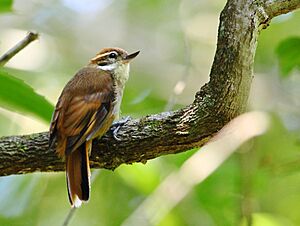White-throated xenops facts for kids
Quick facts for kids White-throated xenops |
|
|---|---|
 |
|
| Conservation status | |
| Scientific classification | |
| Genus: |
Xenops
|
| Species: |
minutus
|
The white-throated xenops (Xenops minutus) is a small passerine bird. It belongs to the ovenbird family called Furnariidae. You can find this bird in parts of South America, including Argentina, Brazil, and Paraguay.
Contents
About the White-Throated Xenops
How Scientists Classify This Bird
Scientists group living things to understand them better. The white-throated xenops was once thought to be the same as another bird, the plain xenops. But now, many experts believe they are different species.
Some groups, like HBW and IOC, agree they are separate. Other groups, like SACC and the Clements taxonomy, still consider them one species. This shows how science can change as we learn more!
The white-throated xenops is a "monotypic" species. This means there are no different types or subspecies of this particular bird.
What Does It Look Like?
The white-throated xenops is about 12 cm (4.7 in) long. It weighs around 10 to 13 grams (0.35 to 0.46 oz). That's about as much as a few paperclips!
This bird has a special beak. It is wedge-shaped, a bit short, and points slightly upwards. Both male and female birds look the same. Young birds also look like the adults.
Adults have a bright, light-colored stripe above their eye. This is called a supercilium. They also have a wide white stripe on their cheek, called a malar stripe. Their back is dull brown or reddish-brown and smooth. Their head is darker with light streaks.
Their tail is cinnamon-colored with a lot of black. Their wings are also cinnamon, with a wide yellowish-brown band on the flight feathers. Their throat is pale and usually has no streaks. The rest of their belly is plain, dull grayish-brown.
Their eyes are dark brown. Their upper beak is dull black, and their lower beak is dull grayish-white with a dark gray tip. Their legs and feet are bluish-gray.
Where Does It Live?
The white-throated xenops lives in eastern and southeastern Brazil. You can find it from Bahia state down to Santa Catarina state. It also lives in eastern Paraguay and northern Argentina's Misiones Province.
This bird likes to live inside and at the edges of many types of forests. This includes tropical lowland forests, forests that lose some leaves, older secondary forests (forests that grew back after being cut down), and gallery forests (forests along rivers). It can live from sea level up to about 1,500 meters (4,900 ft) high.
White-Throated Xenops Behavior
Movement and Travel
The white-throated xenops stays in the same area all year long. It does not migrate to other places.
What Does It Eat?
This bird mostly eats small creatures called arthropods. These include adult insects and their young. It has been seen eating termites, ants, bees, beetles, katydids, millipedes, and spiders.
It usually looks for food in the lower and middle parts of the forest. But it can also go up to the very top of the trees. It often joins groups of different bird species that are foraging together.
The white-throated xenops uses its special upturned beak to find food. It picks up prey, hammers at bark, chisels into wood, and pries open cracks. It often looks for food on thin, dead branches, especially rotten ones or those that have fallen to the ground. It also feeds along vines.
Reproduction and Life Cycle
Scientists have not studied much about how the white-throated xenops reproduces. However, they believe its breeding habits are similar to those of the plain xenops, which is a close relative.
What Does Its Song Sound Like?
The white-throated xenops has a very high, fast song. It sounds like a series of 5 to 10 quick "seep---" notes.
Status and Protection
The IUCN (International Union for Conservation of Nature) has looked at the white-throated xenops. They have assessed it as a species of "Least Concern." This means it is not currently in danger of disappearing.
It lives in a fairly large area. However, we do not know how many of these birds there are. Scientists believe its population might be getting smaller. No immediate threats to the species have been found yet.


